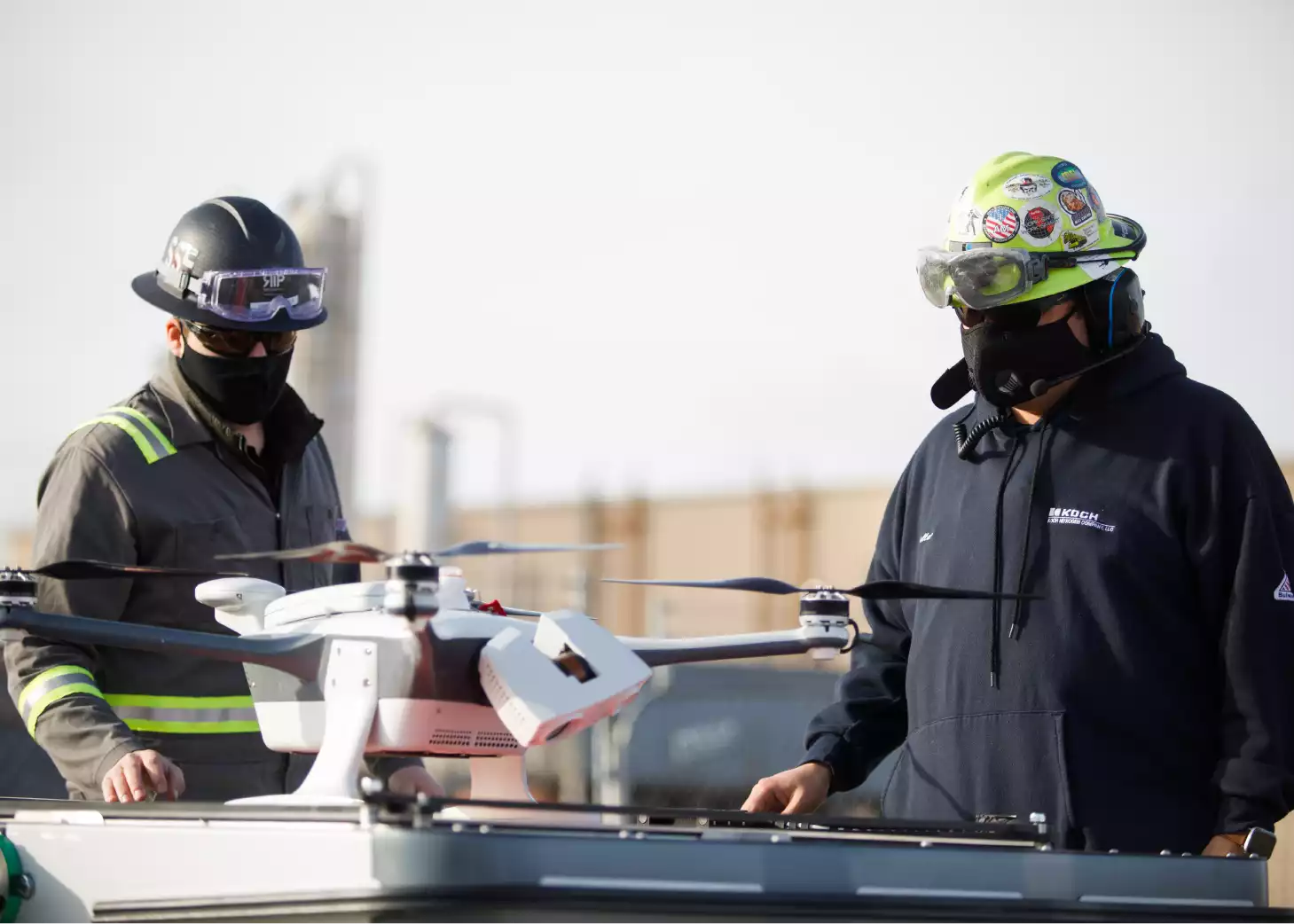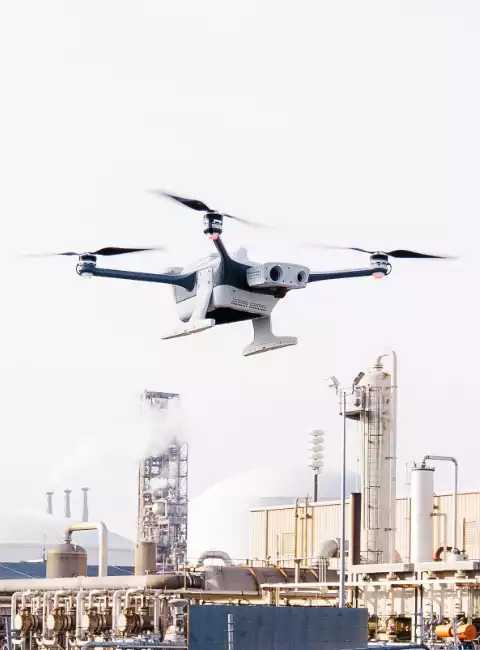April 6, 2021
How Autonomous Drones Drive Change at Koch Fertilizer
For employees and the facility at-large, an experiment with Koch Disruptive Technologies portfolio company Percepto is transforming mundane routine tasks into cutting edge tech.
A team of entrepreneurial tech enthusiasts have helped launch an initiative that is elevating inspection and safety programs at Koch Fertilizer’s largest production facility.
The six-employee team in Enid, Oklahoma, began operating autonomous drones over the 500-plus-acre facility in February (one of the largest fertilizer production plants in North America). The program is designed to alleviate monotonous, difficult and sometimes dangerous — but required — tasks by automating them, says Mike Kleis, vice president of operations and plant manager.
“It’s taking the mundane tasks off of people’s plates so they can work on higher value-added things,” Mike says. “Safety and maintenance tasks can sometimes comprise an employee's entire shift. Autonomous drones can do the same inspection work in minutes — without scaling a 190-foot tower or walking miles of railway inspecting rail cars for leaks. This allows more time for individuals to focus on more fulfilling work.”
All the drone operators volunteered for the program and all are in other roles at Koch's Enid facility. They’ve learned new technologies, acquired new skills and undergone U.S. Federal Aviation Administration training for a pilot’s license, something Wallace White says he never dreamed he’d do. But he knew the autonomous drone program was an opportunity to grow.
“I wanted the chance to transform my job,” he says, which is why he volunteered.
Wallace started at Koch nine years ago, loading ammonia rail cars. After moving into the operations group, he took equipment readings inside the plant and made manual adjustments. Since becoming a console operator, he’s been helping run the plant from the control room. According to Mike, getting a drone pilot’s license was the next logical step in Wallace’s continuous career progression.
“Wallace has taken on a role as an innovation leader for the operations group,” Mike says. “He’s very adept with new technology, so he helps us manage projects to get them in place and integrated.”

Wallace has grown along with the program, designing several automated drone missions that were not in the original plan, such as security sweeps and automating related notifications and paperwork. “Wallace came up with things I never even thought about,” Mike says. “Now we’re sending out an email asking everyone at the plant to suggest what else the autonomous drones might do.”
While Wallace is excited about the new opportunities the autonomous drone program has brought to Enid, he doesn’t believe drone operations will be his final role at Koch. He believes operations will continuously transform.
“I'd like to operate the autonomous drones for a while, but it's also a step toward another future transformation,” he says.
Continuous transformation — of jobs and the facility itself — is the goal at Koch. “We have a vision for our future and programs like this fit right into that,” Mike says.

AI IN THE SKY
Koch’s deployment of the autonomous drone technology is part of Koch Disruptive Technologies' (KDT) Koch Labs program, where partner companies and startups are invited to utilize Koch facilities to develop their technology in real-world working environments. This creates a mutual benefit for the budding startup and Koch facilities and employees looking to transform in new ways.
Israel-based Percepto, a KDT portfolio company, makes the autonomous industrial drones and software platform used by Koch Fertilizer in Enid. These are known as AIM drones (short for “autonomous inspection and monitoring”). The drones, which use artificial intelligence software, are designed to assess risk, minimize downtime, increase safety and reduce operational costs. They feature Percepto’s latest technology, including 3D mapping, wireless broadband backup connection, multiple safety systems and anomaly detection and reporting.
Once programmed, the autonomous drones carry out missions to capture video and images using traditional and infrared cameras. They can also gather information from on-board sensors. Enid is using the autonomous drones to perform tasks such as tank, pump and belt inspections, erosion monitoring, rail inspections, pond level measurements and security assessments. Pipeline inspections and other functions are also in the plans.
If a potential anomaly or problem is detected, Percepto’s software platform sends automated alerts. Enid's mission operators can send the drone to photograph the same location daily for monitoring, or technicians can work to mitigate the issue immediately, preventing minor issues from becoming major problems.
“Fully autonomous inspections and monitoring have been a vision of ours for years. Seeing it in action at sites is at times surreal,” says Percepto’s Hava Sorsky of the autonomous drone program in Enid.

The drones aren’t completely independent — at least, not yet. They fly routes preprogrammed by the pilots, collecting data and mapping the plant campus. Pilots, like Wallace, monitor drone flights to look for abnormalities in flight patterns or anything else that would require a craft to be recalled.
Eventually, as the program matures and the drones learn their routes, even that bit of oversight will be removed and the drones will complete the full cycle autonomously.
“Working with an innovative company that truly understands the value of autonomous tech is a huge advantage for us,” Hava says. “It allows us to push our system to the limits and develop new features and use cases.”
This experimental mindset is built into the culture across Koch. Employees enterprise-wide are encouraged to apply transformative thinking to their daily work.
The success of the Enid experiment has led other Koch Fertilizer facilities to start experimenting and adopting drone technology. Meanwhile, Mike and Wallace are already planning the next step: robots. “Robots that work either with the drones or independently could serve a couple of purposes for us; first and foremost, the enhanced safety of our team,” Mike says.
Percepto is currently partnering with several manufacturers of mobile robots – aerial, wheeled, walking and tracked – to develop this technology. Its vision is to provide a single data analytics and autonomy platform with hardware solutions that would support a wide range of industrial and security operations.
Wallace is completely on board. “It can never hurt to have more eyes in the sky or on the ground,” he says.



